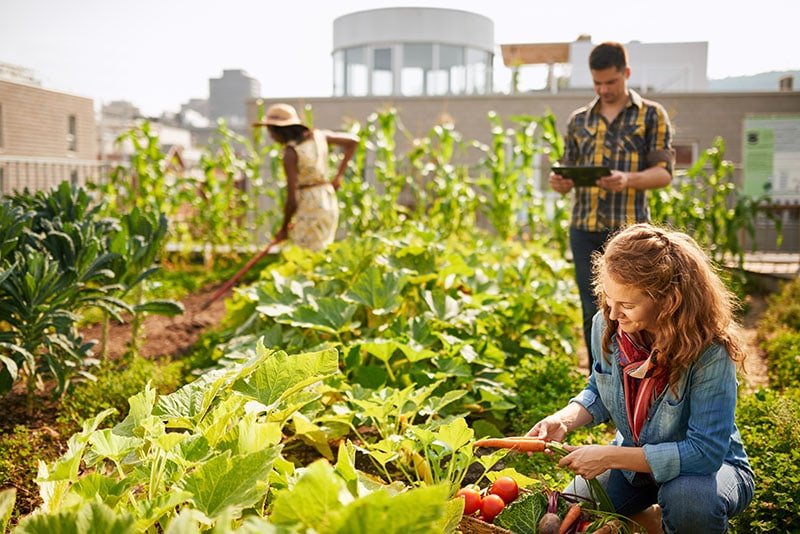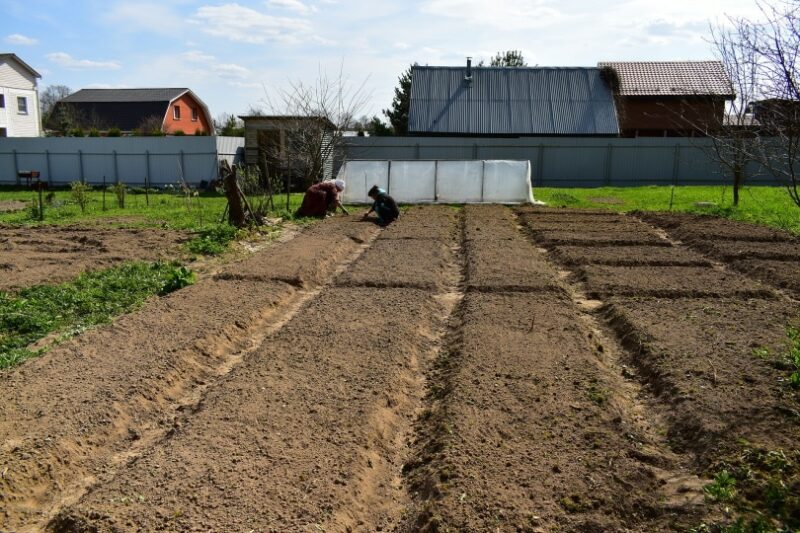What Is a Community Garden? Benefits & Planning
-

- Last updated:

The concept of a community garden seems straightforward, but its execution and benefits to society are far from simple.
A shared gardening space allows community members to enjoy fresh fruits and veggies, beautify their neighborhoods, and even increase their property values.1 But in an age of food scarcity fears and social distancing, community gardens are becoming instrumental in supporting sustainability and higher standards of living. Learn how you can positively impact your life and your neighbors by starting a community garden project in your area.
What Is a Community Garden?
A community garden is a collaborative effort among neighbors in a rural, urban, or suburban area to maintain one or several garden plots. Unlike a park, a community garden doesn’t depend on care from paid professional landscapers. Instead, individuals volunteer their time and finances to plan, develop, and manage the space.
The term “community garden” encompasses several arrangements in numerous locations. You can start a community garden of raised beds behind a church, till beds in an abandoned lot, or build a backyard greenhouse that others can access. You can craft it any way you want based on your available resources and call it a community garden as long as more than one household contributes.

Benefits of a Community Garden
Community gardens are enormously beneficial for the environment, individual community members, and outside groups. As more millennials feel disconnected from their community,2 a shared garden can help neighbors build relationships. And beyond the social and cultural benefits, individuals engaged in a community garden can improve their well-being in several ways, including:
- Developing healthy diets
- Learning about environmental stewardship
- Relaxing and relieving mental stress
- Engaging in more physical activity
A bountiful, thriving garden taking over an unused lot will beautify the space and elevate community standards. The new growth will boost the soil structure and invite pollinators, which could benefit the landscaping around the neighborhood.
The most apparent advantage of a community garden is the produce. Community gardens have always been practical in both rural areas and urban neighborhoods. When there is limited access to fresh produce, a community taking matters into its own hands makes it easier to develop healthier habits. Studies have shown that people involved in community gardens are over three times more likely¹ to eat the proper amount of vegetables.
The nutritional value of one garden can even extend beyond the individuals using it. The pandemic’s effect on grocery store shelves shined a light on food insecurity, and climate change isn’t fueling hope for change anytime soon.
Many people realize that community gardens are valuable for supplementing diets and supplying local non-profits. And when one community helps feed itself, it allows food suppliers to send resources to communities in greater need.

How to Organize a Community Garden
A community garden requires hard work and coordination among motivated residents and local leaders. The first step in developing a garden is finding interested individuals willing to take on leadership roles. These can include business owners, church or school officials, or members of local governments and councils. The following are a few ideas for sparking interest in your neighborhood:
- Talking face-to-face with neighbors
- Attending neighborhood council and organization meetings
- Putting up flyers around popular businesses and locations
- Canvassing the neighborhood
- Setting up a Facebook group for the garden
When you assemble a group of interested community members, you can start planning your garden. Planning and execution will generally take several meetings. From the beginning, it’s crucial to outline a shared leadership strategy. Your group will have to set out various processes for making decisions and resolving issues. Rules can be as flexible as your community desires. But setting expectations is essential to prevent conflict and maintain everyone’s involvement.

Planning the Garden
Your planning committee will need to decide on the garden’s startup and long-term viability. A few critical questions include:
- What are the group’s goals in creating the garden? Will it supply a local food bank or feed individuals in the community? Who will it benefit, and how?
- What garden arrangement and size will suit the needs of the people involved?
- Who can supply labor and materials?
- How will the community divide daily responsibilities?
- Will individual plots be available for rent?
- What kinds of structures (e.g., gathering areas, playgrounds) and plants will the garden contain?
After establishing the direction for your garden, you can break up your group to perform particular tasks.
At this stage, your group can seek sponsorship to help with resources. Partnerships with local churches, schools, and city councils could provide sites and volunteers to support the garden. Local businesses can sign on to supply building materials. You may be able to offer naming rights and publicity for crucial help in setting up the space.

Site Selection
The community garden site must be accessible for everyone interested in using it and visible enough to keep it safe and public. It should receive at least 6 hours of daily direct sunlight and have decent drainage. You may also need to test the soil quality to ensure your plants will flourish.
You can approach private and public landowners with a proposal letter representing your group. Be ready to negotiate land use and compensation for the owner, and consider insurance to protect every stakeholder. Shoot for at least a 3-year lease on the land. The longer the lease, the more flexibility you’ll have in planning your garden, especially for slower-growing plants.
Other considerations include the ongoing upkeep of the garden. You’ll need to figure out how to irrigate the beds and supply electricity as needed. Alongside the various fences, borders, and raised garden structures, you must plan who will install and pay for these utilities.

Garden Management
Once the site is secure, it’s time to lay out the plots and design the garden. The committee must make critical decisions around membership, dues, and finalized rules and responsibilities. You’ll need to write down a meeting schedule, maintenance checklist, and list of communal supplies to ensure everyone is on the same page and capable of completing the gardening duties.
There are several goals, organizational structures, and formal garden bylaws to consider, and the rigidity of your community garden will depend on everyone’s comfort level. Clarity around individual roles and garden rules is essential, regardless of how your group manages itself. Get your regulations in writing to provide to each member, and keep open lines of communication through online groups and a garden email account.
Final Thoughts
Community gardens take lots of ongoing work from dedicated volunteers to be successful. But for anyone that contributes, the mental, physical, social, and spiritual benefits make every garden worth the investment.
Every new garden is a case study of the power of individuals collaborating to achieve something greater than the project itself. Consider opportunities in your area and among your neighbors to improve the community, help those in need, and set a positive example for future generations.
Featured Image Credit: DisobeyArt, Shutterstock
Contents

